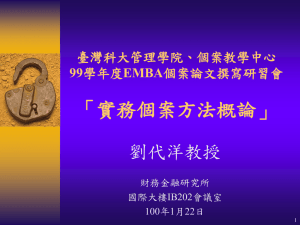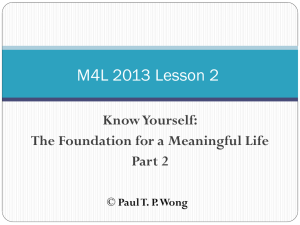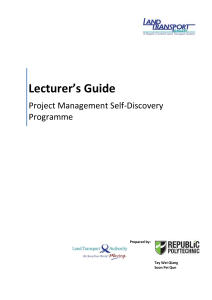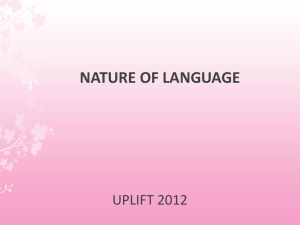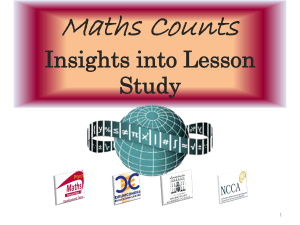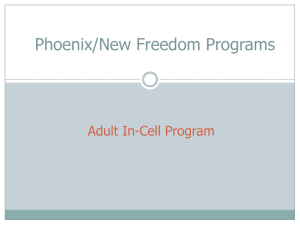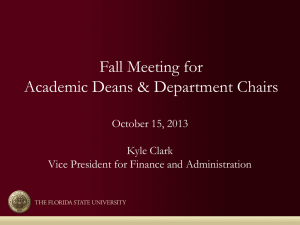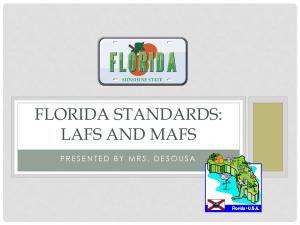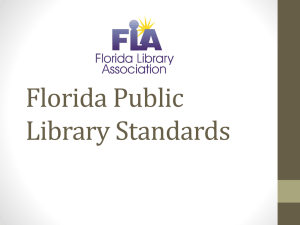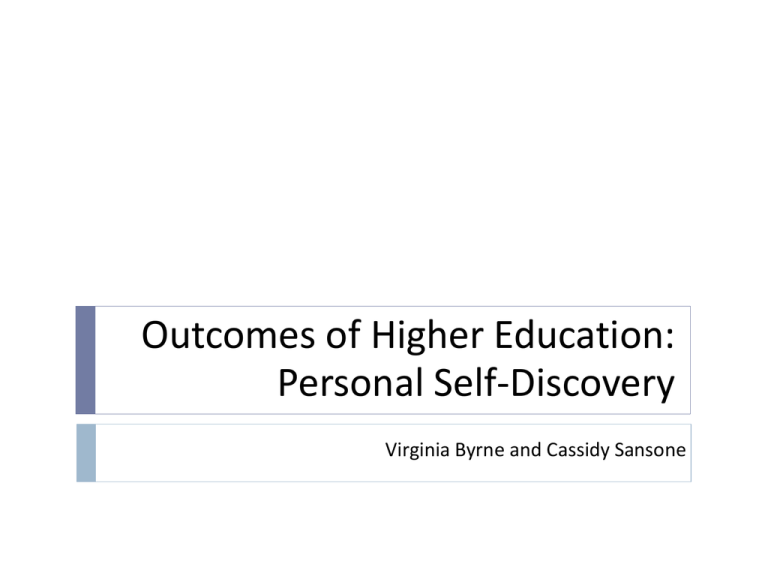
Outcomes of Higher Education:
Personal Self-Discovery
Virginia Byrne and Cassidy Sansone
Self-Discovery as an Outcome: Why?
Personal self-discovery
is “one of the most far-reaching purposes of higher
education” 1
Universities strive to enable students to find themselves and their purpose
Personal self-discovery is “Knowledge of one’s own talents, interests, values,
aspirations, and weaknesses [and] discovery of unique personal identity”2
The nature of the college environment provides innate opportunities for
students to self-discover
We want students to be able to internalize the lessons they learn and the
encounters they have with others in order to help them better understand
themselves
By assessing, we as an institution can tailor programming to help students
with specific developmental needs.
1 (Bowen, 1977, p.28 )
2 (Bowen, 1977, p.35)
How do we define self-discovery?
The six ways self-discovery can be intentionally facilitated:
1.
2.
3.
4.
5.
6.
“Turning point” moments and key experiences exist in programs which
1.
2.
3.
4.
Introduce students to a wide range of ideas
Provide opportunities to meet peers and role models
Assist students in considering new paths for life after graduation
Allow students to test a variety of fields and tasks
Help students discover their limitations; and
Motivate students to reach their full potential as humans 1
push students to their limits,
require students to play an active role instead of a passive one,
have a measure of uncertainty,
require students to face the possibility of failure.2
Our primary research goal is not how students define self-discovery or
whether or not they have some type of self-discovery during their college
career
Instead, for those students who have experienced personal self-discovery, we hope to identify
what type of environment, staff, and experience was needed to create this growth.
1 (Bowen, 1977, p. 28)
2 (Yair, 2008)
Self-Discovery Focused:
Introduce students to a wide range of ideas
Narrowing
the focus: introducing students to a wide range of
ideas
Considering Yair’s four characteristics, opening up to new ideas
stretched a student’s comfort level,
asks him or her to be engaged, and
puts the student in a place where lack of knowledge could make him or her seem
ignorant or naive (a fear of social failure).
Surveying Florida State University’s undergraduate
population in regards to their involvement in programming
designed to expand students’ ways of thinking
Programs that require close interactions with unfamiliar students,
social groups, and ideas will help students to develop an
understanding of and learn to accept difference
Assessment Procedure:
Learning Outcomes
How
do students define self-discovery?
Have FSU students obtained a sense of self-discovery upon
graduation?
Do students who participate in programs that introduce students
to a wide range of ideas leave with a sense of self-discovery?
Do students who do not participate in programs that introduce
students to a wide range of ideas leave with a sense of selfdiscovery?
What aspects of programs, courses, or experiential learning
opportunities best facilitate students’ realization of self-discovery?
Assessment Procedure:
Research Sample & Input Data
Simple
random sample of FSU students
Surveyed at their entry to and exit from campus.
Suskie1
recommends a random sample to ensure that the sample
is actually representative of the population.
Controlled for those students who intentionally who self-select into
diversity, global education, and other exploratory specific programs.
Other input variables were held constant based on availability and
suitability of responses such as sex, race, socioeconomic status, and
academic programs.
1 (Suskie, 1992)
Assessment Procedure:
Environmental Data
Variables chosen based on research1 on what experiences enable
students to think critically, develop an appreciation for differences, and
gain self-understanding
Also must require close interactions with unfamiliar students, social groups, and
ideas, which help students to develop an understanding of and learn to accept
differences
Environmental variables chosen include:
Extracurricular activities engagement (two hours or more per week, on average),
Academic coursework,
Other experiential learning engagement,
On-university based involvement (community, church, employment, etc), and
Level of challenge.
1 Bowen (1977), Yair (2008), and Chickering & Reisser (1993)
Assessment Implementation:
Gathering Outcome Data
Comprehensive
Pre- and post-tests of a quantitative survey
Qualitative focus groups to assess the “talent development”1 of
undergraduate students
Note: we will not directly assess self-discovery in college students through selfreporting
Other
assessment program consisting of:
methods of assessment:
Comparing ourselves to other Florida institutions
Nationally-accepted standards
For example, National Survey of Student Engagement (NSSE) & Collegiate Learning
Assessment (CLA)
1 (Astin, 1996, p.6)
Assessment Results
Results showed that students who engage in dialogue and
experiential learning with those of different viewpoints and
walks of life exhibit significant levels of self-discovery.1
Identifying what type of environment, staff, and experience was
needed to create this growth
Examples from respondents include:
randomly assigned roommates in the residence halls
randomly assigned group projects
living-learning communities, and
multicultural programming.
1 (as defined by Bowen and Yair; see Slide 3)
What Our Results Mean
Fulfilling our duty to state policy makers
Communicating that our work (and spending) has been assessed to ensure that we are
increasing student self-discovery
Fulfilling our duty to our community
To ensure the state of Florida is competing in national business and discourse, our
graduates must be confident in relating with people from every walk of life.
Graduates must also be empowered to become global citizens and leaders, making them
competitive in the global marketplace of ideas.
Fulfilling our duty to our students
Student development is one of the most sought-after outcomes—for both educators and
students—of attending college.
By challenging students more, both inside and outside the classroom, FSU is expanding
their critical thinking, interpersonal, reflection, and many other skill sets that will benefit
them for the rest of their lives.
Who We're Sharing our Results With
University
All parties invested in student development and fostering self-discovery
inside and outside of the classroom
Florida
Administrators, staff, and faculty
state policy makers
Encourage collaboration and build relationships between Florida policy
makers and Florida State university administration
Demonstrate how FSU is cultivating citizens with an awareness of
themselves and their vison for the community.
"The most fundamental state interest [is] to develop the talents of the
state’s citizens as fully as possible.“1
1 (Astin, 1996, p. 218)
Limitations & Criticisms
Our
assessment is simply regarding the self-discovery of FSU
students in light of the programs offered here on campus.
One of our main intentions is to increase trust and cooperation between
Florida policy makers and Florida State University administration
specifically1
Although
FSU is a large public institution, results are not
generalizable to all public institutions of higher education.
assessed one of the six ways2 to intentionally facilitate
self-discovery. We recommend that more research is done in the
future focusing on the other 5 methods.
We only
1 (Astin, 1996).
2 (Bowen, 1977)
Recommendations
Policy makers, faculty, university staff, and students alike must put
more emphasis on the need for diversity and exploratory programs
The results of this assessment will be used to provide feedback to students
interested in developing themselves and gaining personal self-discovery, as well as
improving the organization of higher education1
Florida State University should institute a comprehensive longitudinal
student database of all FSU students’ input, environment, and outcome
information, organized by cohort1
Examples of the information in this proposed database include:
our controlled input variables;
environmental factors such as extracurricular involvement, academic curricula, staff
interaction, internship experience; and
outcomes including post-graduation aspirations and career plans, community involvement,
self-awareness, values, global perspectives, and etc.
1 (Astin, 1996).
References
Astin, A.W. (1996). Assessment for excellence: The philosophy and practice of assessment and
evaluation in higher education. Phoenix, AZ: ACE/The Oryx Press.
Bowen, H. (1977). Investment in learning. San Francisco: Jossey-Bass.
Chickering, A.W., & Reisser, L. (1993). Education and identity (2nd ed.). San Fransisco: JosseyBass.
Evans, N. J., Forney, D. S., Guido, F. M., Patton, L. D., & Renn, K. A. (2010). Student
development in college: Theory, research, and practice (2nd ed). San Francisco:
Jossey-Bass.
Suskie, L. A. (1992). Questionnaire survey research: What works (2nd Ed.). Tallahassee, FL:
Association for Institutional Research.
Upcraft, M. L. and Schuh, J. (1996) Assessment in student affairs. San Francisco: Jossey-Bass,
Inc.
Yair, G. (2008). Key educational experiences and self-discovery in higher education. Teaching
& Teacher Education, 24(1), 92-103. doi:10.1016/j.tate.2007.04.002


